Pancetta is Italian cured pork belly. I had looked into making it myself before, but the recipes I found required a curing chamber. A curing chamber is a cabinet with controlled temperature and humidity. Even for me it seems over the top to own one. But then I realised that pancetta was originally invented to preserve pork belly when refrigerators had not yet been invented (let alone curing chambers), so I figured that a cellar should do the trick as well. We don’t have a cellar, but in winter our garage comes pretty close with a temperature around 16ºC/60ºF. So I compared many recipes I found online on Italian blogs, on American blogs, and in the end based my first homemade pancetta upon a Dutch blog called missFromage (I bet Shanna likes that name!).
Making your own pancetta is quite easy and not a lot of work, it just requires a bit of patience. The result was great! My first homemade pancetta has a more elegant and detailed flavor than store-bought pancetta available around here. As an added bonus it is cheaper as well. Thanks missFromage for making it look as easy as it actually is! I will definitely make this again.

The start is always a nice piece of pork belly. The first step is to salt the pork belly and refrigerate it for 7-10 days. There are many variations on the spices that are added to the salt for this process, and many variations on how to do this including putting the pancetta on an inclined surface so the juice flows down, using a ziploc bag and turning and massaging the pork belly on a daily basis, and putting a weight on top of the pork belly like when making gravlax. I decided to keep it simple and vacuum seal the pork belly with the salt and spice mix. Another decision to take here is whether to add nitrates at this point. Nitrite or nitrate (curing salt, pink salt, or saltpeter) are used to protect against botulism. Americans will probably decide to use it. The risk of botulism in an intact muscle like pork belly is very low, and in Europe it is not traditional to use it. Nitrates/nitrites change the color and the flavor of the pancetta.
The second step is to rinse off the salt and cure the pancetta by hanging it up to dry for at least a week. Some recipes wash the pancetta with white wine. You can decide to roll up your pancetta, or keep it flat (pancetta tesa in Italian). It is a good idea to protect the pancetta from bugs and other outside influences while it is curing. If you don’t have a curing chamber, you can build a cage with a mosquito net around it, or wrap the pancetta in cloth. You will need a place where air can flow freely and the temperature is below 20ºC/68ºF or so. My garage did a fine job. A final decision is how long to cure the pancetta. I was too curious what is what like after two weeks, but I’ll probably leave it for another week or so next time as it had not yet reached a weight reduction of 1/3, which is indicated for pancetta. Here’s what I did…
Ingredients
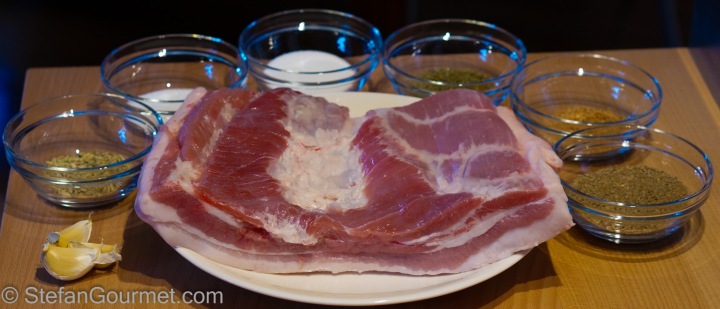
Will yield about 1 kilogram (2.2 lbs) of pancetta
1500 grams (3.3 lbs) pork belly, without rind
45 grams (3%) salt, about 2 Tbsp
22.5 grams (1.5%) freshly ground black pepper, about 3 Tbsp
22.5 grams (1.5%) sugar, about 1 1/2 Tbsp
4.5 grams (0.3%) freshly grated nutmeg, about 1 1/2 Tbsp
7.5 grams (0.5%) fennel seeds, about 1 Tbsp
7.5 grams (0.5%) dried thyme, about 2 Tbsp
3 cloves garlic, minced
Also needed
more freshly ground black pepper
neutral white wine
string and cloth
Preparation

Combine the salt and spices in a bowl.

Trim any loose pieces from the pork belly to make it even. Rub the mixture on all sides of the piece of pork belly. Make sure it is covered everywhere, also in nooks and crannies.

Vacuum seal, or put in a ziploc bag. Refrigerate for 7-10 days and turn over daily.
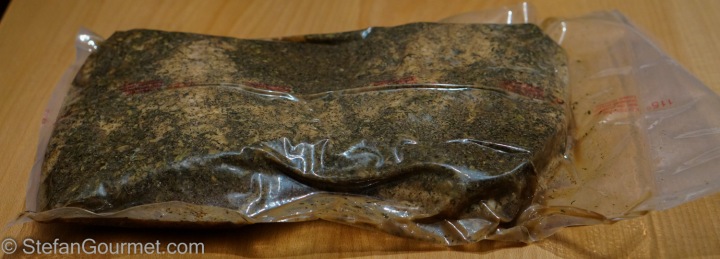
After 7-10 days, the pork belly should feel hard and will have released some liquid.

Take it out of the bag and rinse it under cold running water.
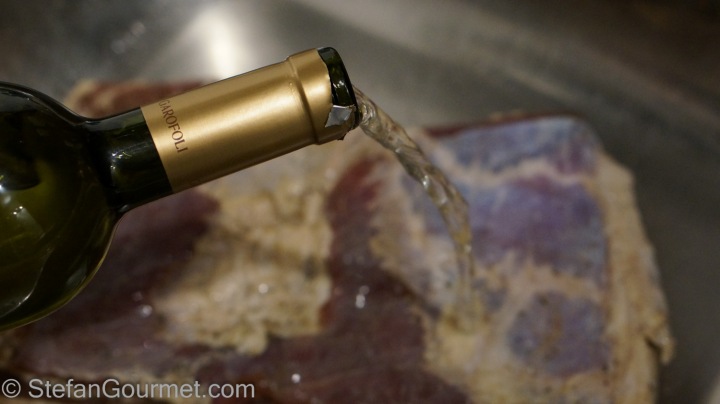
Wash the pancetta with white wine. This provides some flavor and also disinfects.
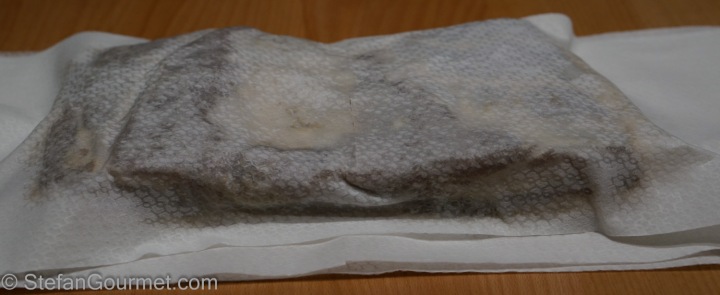
Pat dry thoroughly with paper towels.

Season the meat side with freshly ground black pepper.

Find a clean piece of cloth that is big enough to wrap the pancetta.

Wrap the pancetta in the cloth and secure with string.

Hang the pancetta in a dark and cool place with some airflow (not drafty), preferably with relative humidity of around 60% and a temperature around 16ºC/60ºF.

Wait at least one week for flat pancetta or two weeks for pancetta that has been rolled up. It is best to wait until the weight has been reduced to 66% of the original weight.
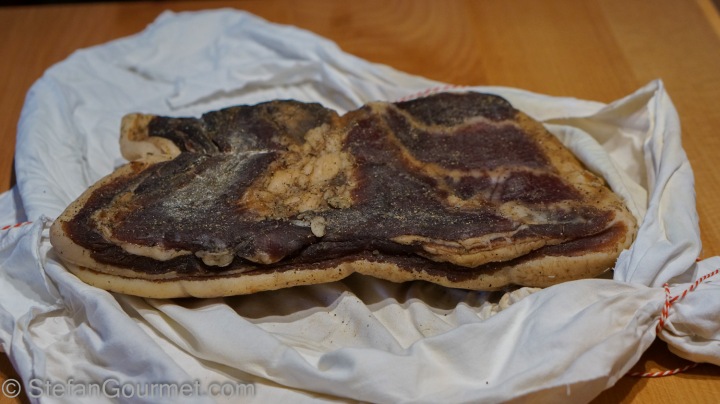
Untie and unwrap the pancetta. It is now done!

Wrap the pancetta in plastic and store in the refrigerator (for a few weeks) or freezer (for several months). It is best to eat it cooked, but according to some sources it can be eaten without cooking if it has been cured to a weight loss of at least 33%.
Flashback

Two years ago I blogged about classic Dutch pea soup (erwtensoep or snert). Very tasty and very suitable for a cold winter day!



Not bad! It doesn’t seem like much work at all! Is it much better than what you can buy at the store? And there it is sitting pretty on the board, as well! Wonderful!
LikeLike
That depends a bit on which store-bought variety. It is definitely better than most of the stuff available around here, and even better than the one I get from an Italian deli. The flavor has more detail instead of being mostly salty. I was truly surprised at how easy it was to make this.
LikeLike
Stefan, Oh my gosh. OF COURSE you make your own pancetta… and cure it in your GARAGE. Seriously, if you are not a chef and a true devoteé of all things food, no one is. The fennel and neutral wine sound very tasty to me – two lovely flavors dear to my heart. Not that I don’t adore fromage (thank you for the kind mention, by the way – it made me smile). On a side-note, we often store wine in a basement closet, a cellar, which is around 55•F. It sounds like you could probably store wine in your garage during the winter – and have a dynamic and versatile garage for sure! Haha. Best, Shanna
LikeLike
Thanks Shanna, and you are welcome. I do in fact store a lot of wine in my garage, year-round, but in climate-controlled wine fridges that I have set to 54 degrees. (There is still room for the car, too!) Sounds like your basement closet is the perfect temperature for wine indeed. I suppose pancetta is off-limits for you, what a shame 😉
LikeLike
Hi Stefan, this looks fantastic. I have made bacon before and this doesn’t look too different just the added hanging at the end. This post would make a great submission to Our Growing Edge this month. More info here: http://bunnyeatsdesign.com/our-growing-edge and here http://new.inlinkz.com/luwpview.php?id=344321
LikeLike
The hanging is what had me worried because I wasn’t sure whether it would work in my garage, but I shouldn’t have worried. Thanks for reminding me of Our Growing Edge.
LikeLike
tantalizing my tastebuds!
LikeLike
Thanks 🙂
LikeLike
You had me at Pancetta!
LikeLike
🙂
LikeLike
Thank you, Stefan!! I shall certainly try to make this come about June!! And in my garage!! Temps outside – 2 > 8 C in the mornings, never more than 16-18 C in daytime!! Sounds ideal and it would be quite a challenge!! Methinks I could ‘bring it in’ at about 1/4 shop price and very much healthier!!!
LikeLike
Great, let me know how you like it!
LikeLike
complimenti, non è da tutti riuscire a fare in casa una pancetta così
LikeLike
Grazie 🙂 Forse la prossima volta farò guanciale per fare un vero primo laziale.
LikeLike
perfetto
LikeLike
Yeah, Stefan, it’s looking great and yummie!! Good to hear you confirm how easy it is to make your own pancetta. Rubbing and drying, that’s it. Being patient is the hardest part, as I see it.
I know you’re going to do it more often, and experience with herbs and methods 🙂
The second time I made my pancetta, I told my butcher what my plans with the pork belly were. She was really enthousiastic and offered me a space in her smoking cabinet. After the spice bath in my fridge, I brought it back and a few days later I picked up my smoked pancetta. Not traditional, but very tasty!
LikeLike
I will definitely experiment some more. Perhaps my next experiment will be guanciale, as according to my Italian blogger friends that should really be used instead of pancetta for carbonara, amatriciana and gricia.
Pancetta affumicata does exist in Italy, but it is not very common. I can imagine it was very tasty!
LikeLike
Great Post Stefan…. and I have never heard of a curing chamber before. A cool, dry place with a bit of a draft is all you need. Keep an eye out for my post this friday about the Chinese equivalent!
LikeLike
Looking forward to it! With your climate you can probably make this year-round…
LikeLike
only now I’m catching up with your blog. Your post is so beautiful, and it does inspire me start curing meats again. It will be a while before I find a place that allows me to do so, I don’t think the cleaning crew would appreciate finding a piece of meat hanging in the closet here at the hotel… so once I move to a proper place, I will need either a garage or I might turn a wine cooler into a curing chamber which has been one my list of things to do for a very long time.
LikeLike
Thanks Paul. You made me smile when I had a vision of dry curing in a hotel closet 🙂 Hope you will find a new place soon.
LikeLike
🙂 welcome! I saw some bison? recipe really quick, with eggplants… which looked amazing! I’m so behind! seriously, apologies! I’ll catch up!
LikeLike
Take your time — you did miss quite some posts.
LikeLike
I’m feeling that I am lagging behind over here. This is such a great post. Another detailed and excellent post.
Keep it coming!
LikeLike
Thanks, Conor. The board made the picture of the finished product look more sophisticated 🙂
LikeLike
Hi.. its the hanging bit that ‘gets’ me… i love the idea that you hung it in the garage.. I don’t have temp gauges.. yet am sure we are in the right area… gwancharley is wonderful!! http://cookingwithmrfitz.com/?s=guanci&x=0&y=0 and also here!! http://cookingwithmrfitz.com/?s=bacon&x=0&y=0
LikeLike
Gwancharley… I love it 🙂
Good luck with your own guanciale experiment.
LikeLike
Thanks!! will post how it goes!
LikeLike
Cured pancetta,wrapped in cloth ,placed in cellar with fan,
Temp 11.5 deg 82 % Rh hoping to do normal pancetta.(to cook)
And dried loosing 33% to eat uncooked?is humidity too high.
Any pointers ?
LikeLike
Hi Tim, I’m not sure what your question is exactly?
Yes you do need to loose 33% of the fat to be able to eat it uncooked, and yes 82% relative humidity is a bit high, so it will take a long time to lose the 33%. 60-70% is better.
You could reduce the relative humidity by slightly heating the cellar.
LikeLike
Ever fall I tell myself that this is the winter I make pancetta and duck breast prosciutto. Every spring I wonder why I didn’t do either. Thanks for the timely reminder. I may have time yet to make one before my basement gets too warm. Global warming is so inconvenient. 🙂
LikeLiked by 1 person
You should. It is so much better than store-bought. I’ll make pancetta when I get back.
LikeLiked by 1 person
Enjoy the rest of your holiday, Stefan, and safe travels on the way home. 🙂
LikeLiked by 1 person